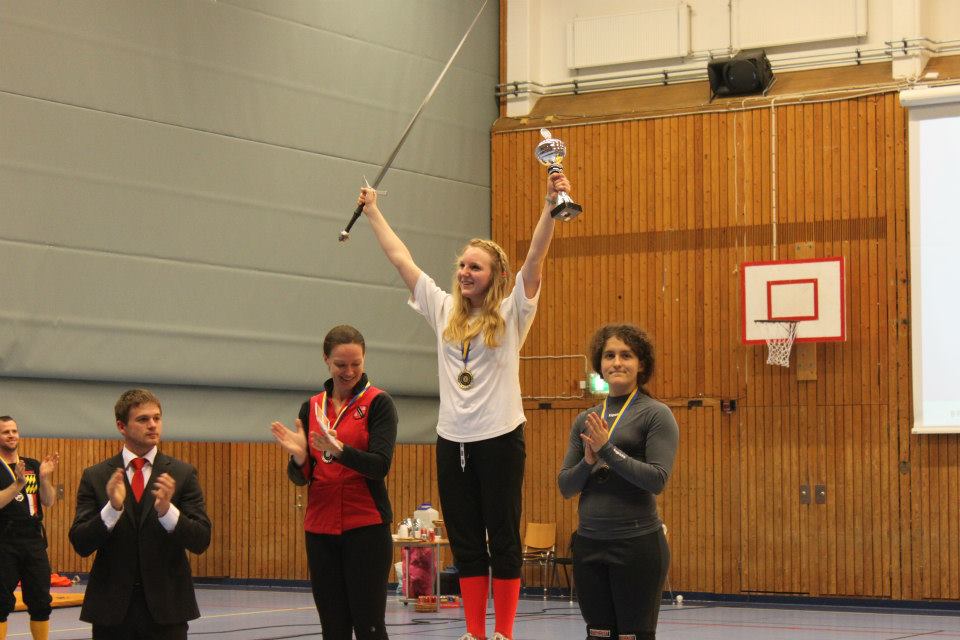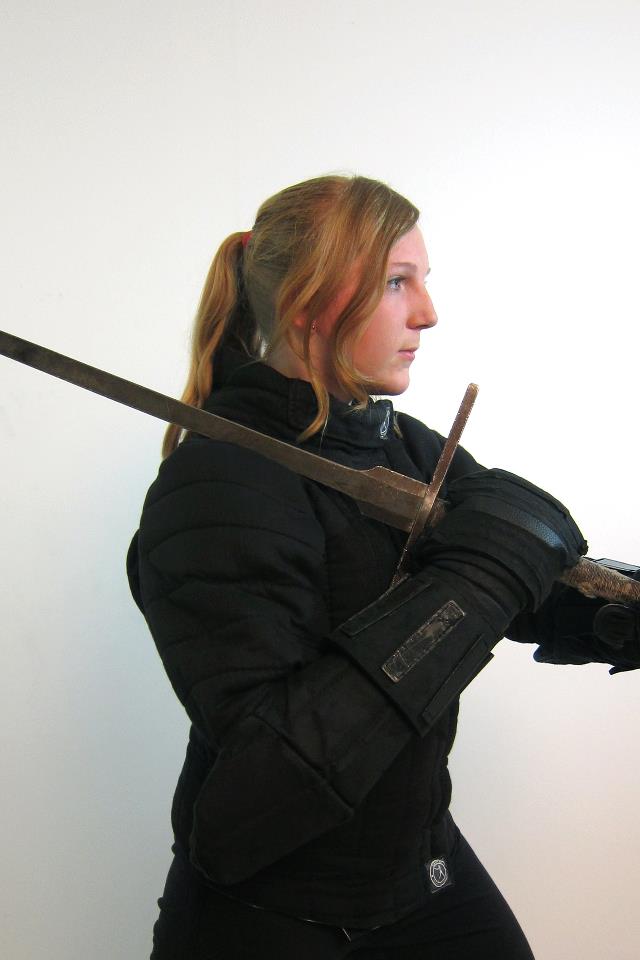Original post: 10 Nov 2012
Interview by Fran Terminiello
The views of the author do not reflect the views of Esfinges
Arguably the highlight of the Swordfish 2012 finals last Saturday night was the Women’s Longsword Final. It was preceded by a close fought exchange between Krisztina Nagy of Hungary and Lena Frederikson of Sweden for bronze. The resulting score of 8-6 left Nagy in third place. The final took place between Jessica Finley of the USA, a well-respected personality in the HEMA scene, and the relatively unknown Märta-Sofie Geijer of Sweden. At just 18 years old, Märta took the event by storm with her ferocity, passion, skill and ultimately her victory with 11 points to 2 that left the live audience on its feet with applause.
A modest and unassuming young woman, Märta has been a familiar face in Esfinges. Her win follows on from a previous gold medal at the Women’s Longsword Tournament held earlier this Summer at Kungskrabba in Sweden, which undoubtedly prepared her for the renowned Swordfish event, held annually in Gothenburg, Sweden.
Hi Marta, so how does it feel to have won such a prestigious title at an international event?
I’m really happy with the tournament and the bouts I got to fight. The final fight against Jessica Finley was one of the best I have ever fought. I’ve recently been uncertain about my fencing, so I’m mostly glad to have found that my style works. I have to say that I’m really impressed with many of the fighters I got to meet at Swordfish. The level of technical skill and heart displayed in the matches is truly amazing. I feel inspired by the colourful bunch of people and the varied fighting styles I have seen and sparred with to continue training and become better.
How long have you been studying HEMA, and what drew you to the art of longsword?
My first contact with HEMA was in school where I saw an advertisement poster from ÖFHF (Örebro Society for Historical Fencing), my club, and said to my friends “that is so cute!”. I got one friend to go with me to my first training. I immediately fell in love with the art and the people in the club. An amazing atmosphere of teasing friendship between scholars, sportsmen and those special people found in HEMA made me want to be a part of it, and I have ever since.

The final match was intense to watch, and the live commentary described you as very aggressive in your fighting style. Is this something you normally employ in your fencing?
Usually I’m not as aggressive as in the final match. That whole attitude was part of my build up strategy for each match. However we do train with very mobile footwork and high intensity in each bout. Usually I fight with people who are a lot better than me, and I know that I have a chance of landing a few blows if I’m aggressive, and hardly any if I am calm. However I always try to develop a fighting style that would be more energy conserving and efficient.
What was going through your mind during the final bout?
In the final I tried to conjure as much anger as I possibly could. The adrenaline was pumping and I think it looks quite funny in the video when I bounce into the middle of the ring. I did not think of the techniques much, I just let the sword go where it wanted. My excellent ringside coach Cristoffer Holm kept saying things, but I did not hear much of that between the adrenaline and the cheer of the audience. One of the things I was most pleased with was that I managed to employ a few techniques from the very good ringen am schwert class held by Jessica Finley I attended the day before.

Why did you choose to enter a women’s longsword tournament and not the open one, do you think in the future you might compete in mixed tournaments?
In my opinion the discussions in the HEMA community concerning female tournaments is slightly off focus from the real issue. Although some girls would rather compete in an all-female tournament, most of the people I’ve talked to don’t think so. The real problem is the very high intensity in the open tournament and the high risk of injury. Also the general level is higher in the open tournament, higher. To want to do well in a tournament is not only a female issue. As a girl I was able to win the tournament after a little more than one year, while in the open I would not have come close to that. As a man the possibilities of getting far are dramatically lower, and I would imagine that going into a tournament with the odds against you is not very motivating. Thus the problem is not gender; it’s the level. According to me the discussions should focus on how divisions could be created in a fair way letting everyone regardless of gender compete at their preferred level. I do realise that such divisions would be very hard to create. Should the time practicing HEMA be counted, or some kind of ranking system employed? I don’t have the answer and doubt that there is a perfect one, but hope that someday this problem will be solved.
You are now a huge inspiration to a lot of fighters. What have you learned from this experience, and what advice could you give to would-be competitors?
One of the most important things this tournament has given me is the realisation of all my weaknesses. I feel more inspired than ever to go on improving and learning more techniques and skills. Skill comes with training and dedication; every hour paying off. The fencing itself is the most important thing in a tournament, and in such a context the focus and intensity are very different from training. The minutes of the tournament sparring are amazing and worth the stress and pressure, giving you a great experience.
Märta-Sofie Geijer

